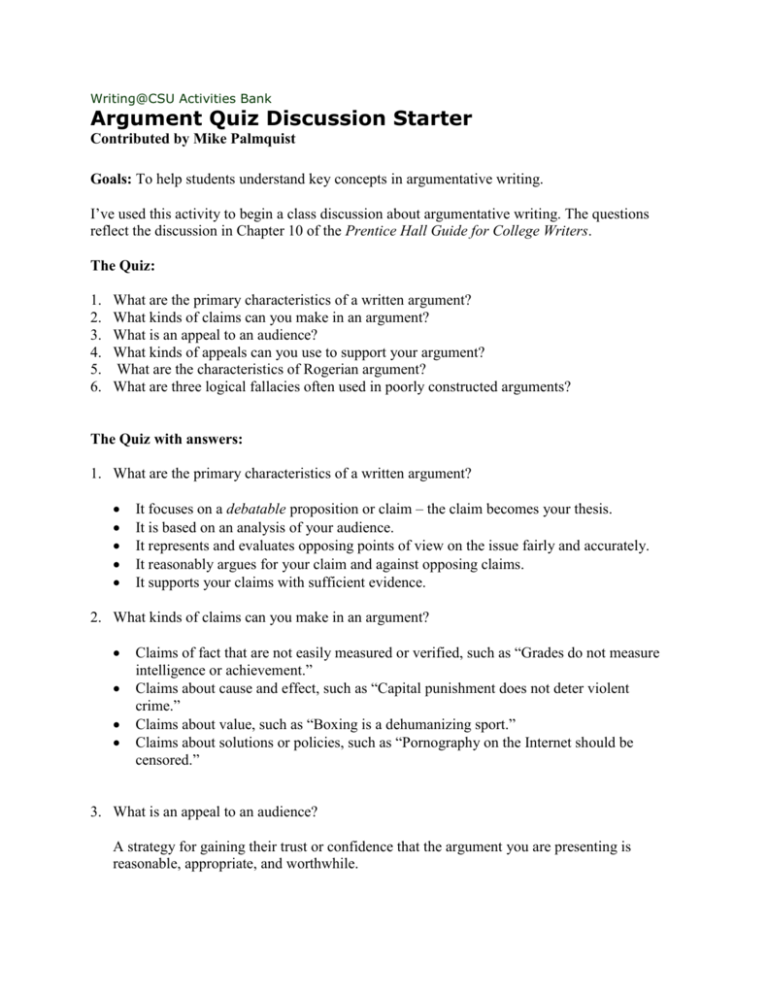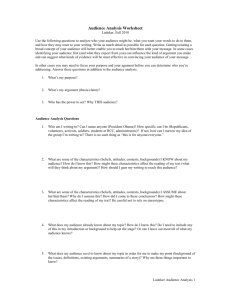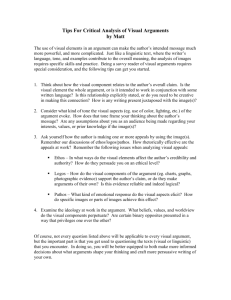Word Format
advertisement

Writing@CSU Activities Bank Argument Quiz Discussion Starter Contributed by Mike Palmquist Goals: To help students understand key concepts in argumentative writing. I’ve used this activity to begin a class discussion about argumentative writing. The questions reflect the discussion in Chapter 10 of the Prentice Hall Guide for College Writers. The Quiz: 1. 2. 3. 4. 5. 6. What are the primary characteristics of a written argument? What kinds of claims can you make in an argument? What is an appeal to an audience? What kinds of appeals can you use to support your argument? What are the characteristics of Rogerian argument? What are three logical fallacies often used in poorly constructed arguments? The Quiz with answers: 1. What are the primary characteristics of a written argument? It focuses on a debatable proposition or claim – the claim becomes your thesis. It is based on an analysis of your audience. It represents and evaluates opposing points of view on the issue fairly and accurately. It reasonably argues for your claim and against opposing claims. It supports your claims with sufficient evidence. 2. What kinds of claims can you make in an argument? Claims of fact that are not easily measured or verified, such as “Grades do not measure intelligence or achievement.” Claims about cause and effect, such as “Capital punishment does not deter violent crime.” Claims about value, such as “Boxing is a dehumanizing sport.” Claims about solutions or policies, such as “Pornography on the Internet should be censored.” 3. What is an appeal to an audience? A strategy for gaining their trust or confidence that the argument you are presenting is reasonable, appropriate, and worthwhile. 4. What kinds of appeals can you use to support your argument? Appeals to reason (logos), such as inductive logic (scientific method). Appeals to character (ethos). Appeals to emotion (pathos). Combined appeals. 5. What are the characteristics of Rogerian argument? It avoids a confrontations stance. It presents your character as reasonable and understanding. It establishes common ground with the opposition. It shows a willingness to change your views. It works toward a compromise or workable solution. 6. What are three logical fallacies often used in poorly constructed arguments? Hasty generalization (conclusion not justified by the evidence). Post hoc ergo propter hoc (faulty causal model). Genetic fallacy (arguing that the origins of a person, object or institution determine its character nature or worth). Begging the question (loading the conclusion in the claim, such as "Useless psychology courses should be dropped from the curriculum"). Circular argument (restating the claim as the conclusion, such as "John is a great teacher because he teaches so well"). Either/or (oversimplifying the issue to a reduced set of choices, such as "America, love it or leave it"). Faulty analogy (comparing two things that aren't necessarily similar enough to justify the comparison, such as "We can resolve the conflict in the Middle East because we resolved the conflict in Panama"). Ad hominem attacks (attacking the character of an individual instead of the worthiness of their position on an issue, such as "Jan's solution will never work because she's a lousy mother"). Ad populum (appealing to popular concepts, such as patriotism, or negative concepts, such as fascism, rather than discussing the real issue). Red herring (using a diversionary tactic rather than addressing the issue). Straw man (unfairly characterizing an opposing viewpoint and then dismantling it).





